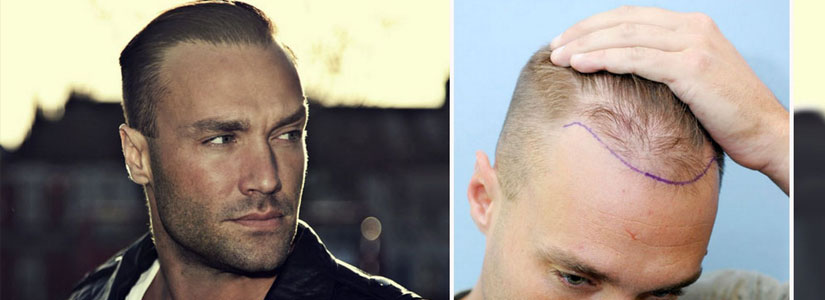Diagnosis And Explanation Of Male Pattern Baldness
December 20, 2016

Experiencing hair loss is common among men and women these days. Every other person is either going through it or has experienced it once in their life. Many men lose all their hair to pattern baldness. This condition is also found in females, but it doesn’t make them entirely bald. Instead, they suffer from diffuse hair loss, losing hair at their temples and part line. Moreover, their hair growth slows down, and hair becomes thinner, finer, and weaker. Due to excessive hair loss or pattern baldness, men and women lose self-confidence. So, they keep trying different medications and home remedies to treat their condition. One such treatment is getting a hair transplant in Dubai. While one may think the hair loss will stop immediately after a transplant, it doesn’t. Many people experience hair loss after a transplant.
In this article, we will shed light on the types of hair loss after a hair transplant and how we can avoid it.
After a hair transplant in Dubai, many people experience hair loss. This type of hair loss is known as shock hair loss or hair shedding. During this hair loss, patients will experience the loss of newly transplanted hair grafts. However, they may not lose all the transplanted hair.
Many people become doubtful about a hair transplant procedure due to shock loss. However, there is no need to worry about this type of hair loss. In maximum cases, hair shedding or shock hair loss is only temporary and stops eventually.
When a hair graft is transplanted, it enters the ‘resting’ phase in its new location on the scalp. So, for healing and establishing its roots in the new place, it will shed first, then, it will become active.
So, instead of worrying about this type of hair loss and considering the transplant unsuccessful, you need to wait patiently. Just follow the post-op instructions and let the transplant take its course, and you’ll see results soon.
The most apparent reason for shock hair loss after a hair transplant is the trauma caused to the scalp. A hair transplant in Dubai is a surgical procedure; therefore, it is invasive. So, the scalp needs to recover from the trauma caused to it by the procedure.
Another reason is the anesthesia used for numbing the scalp before the transplant. Some patients can have a reaction to the anesthesia, and due to this, the transplanted hair grafts may fall out. However, this type of hair loss is also temporary, and the hair follicles will begin to grow after recovery.
The period of shock hair loss can last from a few days to a few months. It depends on different aspects such as the patient’s health, the technique used, the hair transplant surgeon’s expertise, etc. The new hair starts growing after a while, but the rate of growth differs for each individual. At first, the hair won’t be visible and can be felt with fingertips only. However, in a year or a year and a half, the transplant’s final results will be visible.
Although hair shedding or shock hair loss after a transplant is inevitable, it is temporary. The hair that falls out will regrow along with new ones after a while. Even if hair shedding cannot be avoided entirely, it can be minimized. Moreover, by following the given tips, the regrowing hair can also be improved.
So, keep reading to find out the ways to minimize shock hair loss.
Medications are the best way to minimize shock hair loss. They help avoid hair shedding as well as promote hair regrowth.
Two medications are commonly used for minimizing shock hair loss. These medicines include:
Minoxidil has proved beneficial for promoting hair growth and darkening fine hair. These results become noticeable after 4-6 months. While Minoxidil generally doesn’t cause any side-effects, it may cause some minor ones in some patients. Its common side-effects include eye irritation, itching, redness, and unwanted hair growth in body parts other than the scalp.
Finasteride, on the other hand, shows results earlier. It has been reported to deliver results within 3 months. It works by suppressing the DHT production and, in turn, reduces the signs of male pattern baldness. However, it doesn’t work for all men, especially if the cause of their hair loss is not DHT. Moreover, the side-effects of Finasteride are more severe than Minoxidil.
Different cosmetics or camouflaging products are available in the market. Such products can be used for hiding bald spots or any part of the scalp with thin hair. These products help cover the bald spots, and for that they:
Platelet-rich plasma therapy is a hair loss treatment that yields excellent results when combined with a hair transplant.
It helps in preserving and enhancing hair follicles during and after the transplant. Moreover, it also aids and promotes repair and healing after the transplant. It also stimulates the dormant hair follicles and promotes hair growth.
After a hair transplant in Dubai, if a patient gets PRP injections, it can be extremely beneficial. It will help the follicles survive better, and the result will be thicker and better hair.
Our expert surgeons have been performing hair transplants at the Hair Transplant Dubai Clinic for a long time. Since hair shedding or shock hair loss is inevitable, it shouldn’t stop you from getting a hair transplant. This type of hair loss is not permanent. With the help of post-op instructions from our surgeons, you can quickly recover from this phase.
If you are interested in getting a hair transplant from the top-rated surgeons, contact us today. Please fill the form given below to schedule an appointment, and our staff representatives will guide you further.
Dr. Cagatay Sezgin is a celebrity hair transplant surgeon with over 20 years of experience in hair transplantation and restoration. He is the First Turkish Board Surgeon to become a member of the International Society of Hair Restoration Surgery (ISHRS) and the Asian Association of Hair Transplant Surgeons (AAHRS). Moreover, he has the honor of becoming the first hair transplant surgeon in the world to perform hair, eyebrow, and beard transplantation all in one case and that too in a single session.

December 20, 2016

March 24, 2015

October 18, 2017